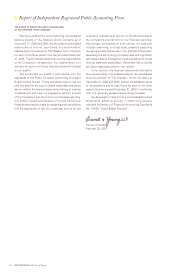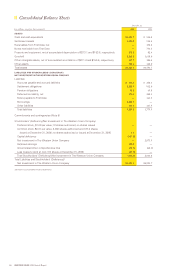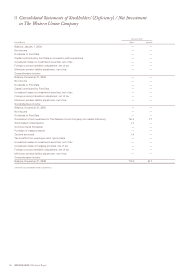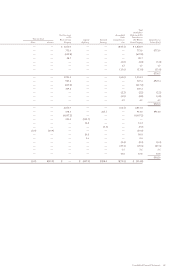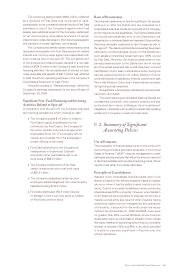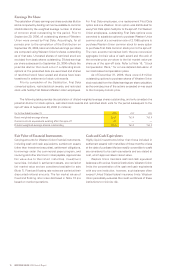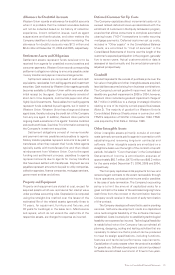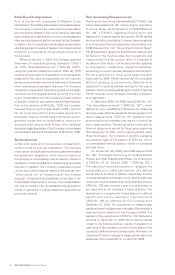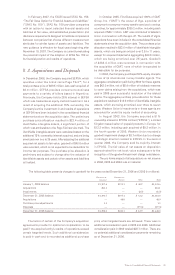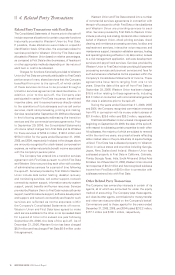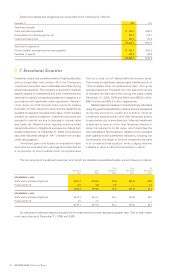Western Union 2006 Annual Report Download - page 73
Download and view the complete annual report
Please find page 73 of the 2006 Western Union annual report below. You can navigate through the pages in the report by either clicking on the pages listed below, or by using the keyword search tool below to find specific information within the annual report. Notes to Consolidated Financial Statements 71
Allowance for Doubtful Accounts
Western Union records an allowance for doubtful accounts
when it is probable that the related receivable balance
will not be collected based on its history of collection
experience, known collection issues, such as agent
suspensions and bankruptcies, and other matters the
Company identifies in its routine collection monitoring. The
allowance for doubtful accounts was $7.3 million and
$8.4 million at December 31, 2006 and 2005, respectively.
Settlement Assets and Obligations
Settlement assets represent funds received or to be
received from agents for unsettled money transfers and
consumer payments. Western Union records corresponding
settlement obligations relating to amounts payable under
money transfer and payment service arrangements.
Settlement assets are comprised of cash and cash
equivalents, receivables from selling agents and investment
securities. Cash received by Western Union agents generally
becomes available to Western Union within one week after
initial receipt by the agent. Cash equivalents consist of
short-term time deposits, commercial paper and other
highly liquid investments. Receivables from selling agents
represent funds collected by such agents, but in transit to
Western Union. Western Union has a large and diverse
agent base, thereby reducing the credit risk of the Company
from any one agent. In addition, Western Union performs
ongoing credit evaluations of its agents’ financial condition
and credit worthiness. See Note 7 for information concerning
the Company’s investment securities.
Settlement obligations consist of money transfer
and payment service payables and payables to agents.
Money transfer payables represent amounts to be paid to
transferees when they request their funds. Most agents
typically settle with transferees first and then obtain
reimbursement from Western Union. Due to the agent
funding and settlement process, payables to agents
represent amounts due to agents for money transfers
that have been settled with transferees. Payment service
payables represent amounts to be paid to utility companies,
collection agencies, finance companies, mortgage servicers,
government entities and others.
Property and Equipment
Property and equipment are stated at cost, except for
acquired assets which are recorded at fair market value
under purchase accounting rules. Depreciation is computed
using the straight-line method over the lesser of the
estimated life of the related assets (generally three to
10 years, for equipment, furniture and fixtures, and
30 years for buildings) or the lease term. Maintenance
and repairs, which do not extend the useful life of the
respective assets, are charged to expense as incurred.
Deferred Customer Set Up Costs
The Company capitalizes direct incremental costs not to
exceed related deferred revenues associated with the
enrollment of customers in the Equity Accelerator program,
a service that allows consumers to complete automated
clearing house (“ACH”) transactions to make recurring
mortgage payments. Deferred customer set up costs,
included in “Other assets” in the Consolidated Balance
Sheets, are amortized to “Cost of services” in the
Consolidated Statements of Income over the length of the
customer’s expected participation in the program, generally
five to seven years. Actual customer attrition data is
assessed at least annually and the amortization period is
adjusted prospectively.
Goodwill
Goodwill represents the excess of purchase price over the
fair value of tangible and other intangible assets acquired,
less liabilities assumed arising from business combinations.
The Company’s annual goodwill impairment test did not
identify any goodwill impairment in 2006 or 2004; however,
Western Union recorded a goodwill impairment charge of
$8.7 million in 2005 due to a change in strategic direction
relating to one of its majority owned prepaid businesses
(Note 3). The majority of goodwill on Western Union’s
Consolidated Balance Sheets arose in connection with
FFMC’s acquisition of WUFSI in November 1994. FFMC
was acquired by First Data in October 1995.
Other Intangible Assets
Other intangible assets primarily consist of contract
costs (primarily amounts paid to agents in connection with
establishing and renewing long-term contracts) and
software. Other intangible assets are amortized on a
straight-line basis over the length of the contract or benefit
periods. Included in “Cost of services” in the Consolidated
Statements of Income is amortization expense of
approximately $68.7 million, $47.5 million and $45.2 million
for the years ended December 31, 2006, 2005 and 2004,
respectively.
The Company capitalizes initial payments for new and
renewed agent contracts to the extent recoverable through
future operations, contractual minimums and/or penalties
in the case of early termination. The Company’s accounting
policy is to limit the amount of capitalized costs for a
given contract to the lesser of the estimated ongoing future
cash flows from the contract or the termination fees the
Company would receive in the event of early termination
of the contract.
The Company develops software that is used in providing
services. Software development costs are capitalized
once technological feasibility of the software has been
established. Costs incurred prior to establishing technological
feasibility are expensed as incurred. Technological feasibility
is established when the Company has completed all
planning, designing, coding and testing activities that are
necessary to determine that a product can be produced
to meet its design specifications, including functions,
features and technical performance requirements.
Capitalization of costs ceases when the product is available
for general use. Software development costs and purchased
software are amortized over a term of three to five years.



